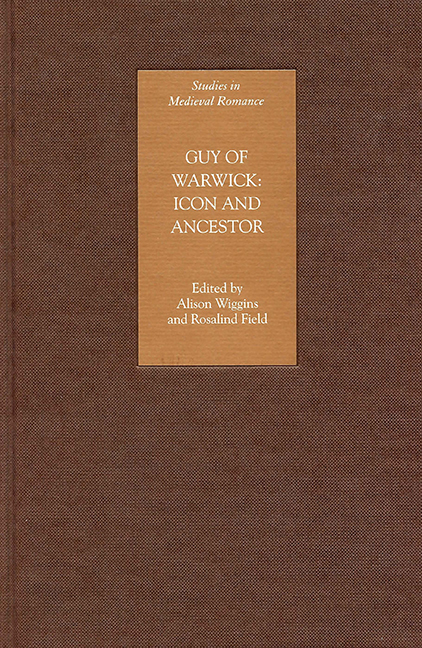Book contents
- Frontmatter
- Contents
- Illustrations
- Contributors
- Abbreviations
- Dedication
- Editorial Introduction: Namoore of this! How to read Guy of Warwick and why
- 1 Gui de Warewic at Home and Abroad: A Hero for Europe
- 2 Gui de Warewic in its Manuscript Context
- 3 Guy of Warwick as a Translation
- 4 From Gui to Guy: The Fashioning of a Popular Romance
- 5 The Manuscripts and Texts of the Middle English Guy of Warwick
- 6 The Speculum Guy de Warwick and Lydgate's Guy of Warwick: The Non-Romance Middle English Tradition
- 7 An Exemplary Life: Guy of Warwick as Medieval Culture-Hero
- 8 The Visual History of Guy of Warwick
- 9 ‘In her owne persone semly and bewteus’: Representing Women in Stories of Guy of Warwick
- 10 Of Dragons and Saracens: Guy and Bevis in Early Print Illustration
- 11 Guy of Warwick and The Faerie Queene, Book II: Chivalry Through the Ages
- 12 Guy as Early Modern English Hero
- Appendix: Synopsis of the Guy of Warwick narrative
- Index
10 - Of Dragons and Saracens: Guy and Bevis in Early Print Illustration
Published online by Cambridge University Press: 24 October 2017
- Frontmatter
- Contents
- Illustrations
- Contributors
- Abbreviations
- Dedication
- Editorial Introduction: Namoore of this! How to read Guy of Warwick and why
- 1 Gui de Warewic at Home and Abroad: A Hero for Europe
- 2 Gui de Warewic in its Manuscript Context
- 3 Guy of Warwick as a Translation
- 4 From Gui to Guy: The Fashioning of a Popular Romance
- 5 The Manuscripts and Texts of the Middle English Guy of Warwick
- 6 The Speculum Guy de Warwick and Lydgate's Guy of Warwick: The Non-Romance Middle English Tradition
- 7 An Exemplary Life: Guy of Warwick as Medieval Culture-Hero
- 8 The Visual History of Guy of Warwick
- 9 ‘In her owne persone semly and bewteus’: Representing Women in Stories of Guy of Warwick
- 10 Of Dragons and Saracens: Guy and Bevis in Early Print Illustration
- 11 Guy of Warwick and The Faerie Queene, Book II: Chivalry Through the Ages
- 12 Guy as Early Modern English Hero
- Appendix: Synopsis of the Guy of Warwick narrative
- Index
Summary
Men speken of romances of prys,
Of Horn child and of Ypotys,
Of Beves and sir Gy,
Of sir Lybeux and Pleyndamour –
But sir Thopas, he bereth the flour
Of roial chivalry!
Shortly before Harry Bailey's protest puts an end to his ‘drasty speche’, the Chaucer-pilgrim lists the heroes of romance to whom his Thopas should be (favourably) compared. While the list includes the obscure and possibly the non-existent, it also invokes such well-known figures as King Horn and Bevis of Hampton, and it is often argued that, in the structure and form of Thopas, Chaucer was particularly targeting Guy of Warwick. This attention to Guy and his fellow romance-heroes is hardly intended to be flattering, but what is more important – what serves as the point of departure for this chapter – is the yoking together of Bevis and Guy. In this practice Chaucer of course reflects the manuscript history of these romances, but he also anticipates what would become a critical norm in later assessments of the nature (and value) of these texts. Thomas Warton may be said to originate this trend in literary criticism in his History of English Poetry (1774). He links Bevis and Guy in his asser- tion that ‘monks often wrote for the minstrels’, and he treats them together in a section on English romances received from the French. Joseph Ritson also joins the two in his ‘Dissertation on Romance and Mintrelsy’, noting that ‘Bevis and Guy were no more “English heroes” than Amadis de Gaule or Perceforest: they are mere creatures of the imagination, and onely obtain an establishment in history because (like mister Wartons) it is usually writen upon the authority of romance’. And many of the first modern anthologizers and critics of romance follow this early lead, both categorizing the romances together and then – and this is the significant point – allowing one to stand as definitive of both.
I cite Ritson here not merely as an early example of this persistent trend; for despite his linking of the two romances, Ritson also shows an unusual awareness of the complex (and different) manuscript and print histories of Bevis and Guy, observing that all ’are extant in MSS.
- Type
- Chapter
- Information
- Guy of Warwick: Icon and Ancestor , pp. 154 - 168Publisher: Boydell & BrewerPrint publication year: 2007



